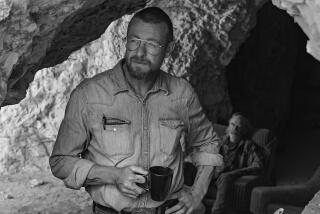Review: In ‘Antarctica,’ human element adds warmth to frigid land
Filmmaker Anthony Powell has, he says, spent most of his adult life in Antarctica, living at the bottom of the world for more than 100 months (including nine very cold winters) spread out over a 15-year period.
What his friends back home in New Zealand most want to know, he says, is “what’s it like down there?” The unexpectedly entertaining documentary he made in response, “Antarctica: A Year on Ice,” provides an engaging and fascinating answer.
“Antarctica” is successful because it operates on two complementary levels, the epic visuals whose grandeur can stagger you and the small-scale personal stories of the people who live and work down there.
With a land mass larger than the United States, Antarctica is so huge it contains places where no human has ever set foot. Powell, whose job is to set up remote radio equipment for the New Zealand base, has seen more of it than most, even spots so remote they offer the rare experience of absolute silence.
Powell not only shot the film as well as directed it, he often had to invent and build his own equipment to deal with working in Antarctica’s inevitable brutal cold, which does things like freeze a camera’s LCD display.
More than being an inventor, Powell has an excellent eye, giving us everything from startling expanses of northern lights to an amusing shot of people sleeping in identical red parkas on an inbound flight. He is also a devotee of time-lapse photography, which he feels “brings out the dynamic forces in nature,” of which there are many.
But what makes “Antarctica” special are its glimpses of Powell’s colleagues, the folks who come back year in and year out, not just the scientists who show up in the summer and appear in nature documentaries, but, as one of them says, “real people just like you and me, average citizens working and doing jobs.”
Powell interviews a lot of these individuals, including Christine Powell, the woman he met in Antarctica who became his wife. Men far outnumber women there, which has led to a pithy saying among the women to the effect that “the odds are good but the goods are odd.”
Because there is nowhere to go and no place to escape to, the quality most necessary to live and work down there is a tolerance for other people, which turns out to be widespread. “Nations get along better here than anywhere else in the world,” one woman says. “It’s special.”
The most significant divide in Antarctica is not between men and women but between the 5,000 people who live there during the summer and the fewer than 700, including Powell, who remain during the devastating winters and participate in a variety of wacky endeavors, which he has unfailingly caught on camera.
The summer is when most of the scientific research is done, and when abundant wildlife like the amusing-to-observe Adélie penguins can be seen cavorting en masse, entertaining shots, Powell informs, which don’t capture the sight of thousands of frozen penguin carcasses and the stench of mass bathroom behavior.
But once the summer people leave, those who remain have to get used to living in a world without light, a four-month-long situation which, among other things, leads to the ability to see the stars with an intensity that is unequaled.
Also out of the ordinary are winter weather conditions, which Christine demonstrates by tossing a cup of boiling water into 40-below-zero air and watching it instantly turn to snow.
Also needing to be seen to be believed is the way wind-driven snow will fill up an entire bunkhouse if only the tiniest crack in the walls is present. This is not only the most isolated place on the planet, but one of the most unusual as well.
Twitter: @KennethTuran
------------
‘Antarctica: A Year on Ice’
MPAA rating: PG for mild thematic elements and language
Running time: 1 hour, 31 minutes
Playing Landmark’s Nuart, West Los Angeles
More to Read
Only good movies
Get the Indie Focus newsletter, Mark Olsen's weekly guide to the world of cinema.
You may occasionally receive promotional content from the Los Angeles Times.







